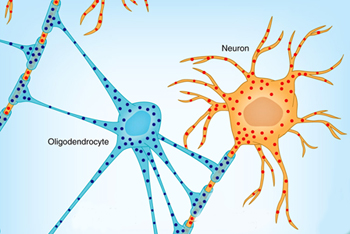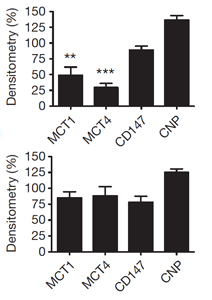
Insular Messaging. Oligodendrocytes ensure that messages are delivered by neurons quickly and efficiently by insulating (myelinating) them. Adapted from Aubourg, P. (2007), Nature Genetics. Courtesy of Nature Publishing Group. All rights reserved.
In people with ALS, the motor nerves deteriorate leading to muscle weakness and paralysis. Astrocytes and microglia, entrusted to support and protect these cells, turn traitor spewing out neurotoxic cytokines, contributing to disease progression.
ALS, however, is fueled by much more than a perfect storm of neurotoxic substances. Motor neurons face an energy crisis. And, scientists suspect, are without a plan B. Oligodendrocytes, which may help keep the power on in motor neurons, are also disappearing over the course of the disease.
Now, researchers from Johns Hopkins University School of Medicine led by neurologist Jeff Rothstein MD PhD report that oligodendrocytes appear to be the main supplier of energy-rich lactate to nerve cells. And, cutting off the supply of this critical metabolite may lead to neurodegenerative disease.
These results add to growing evidence that the loss of oligodendrocytes in the brain and spinal cord may contribute to the onset and progression of ALS.
The results are published online this month in the journal Nature.

Power hungry. Scientists found that ALS-ravaged motor cortex (a) expresses less than half the level of lactate exporters MCT1 and MCT4 than unaffected regions of the brain (b) in people with ALS suggesting that an interruption in the supply chain might contribute to the disease. Image: Lee, Y. et al. (2012), Nature. Courtesy of Nature Publishing Group.All rights reserved.
The Johns Hopkins University School of Medicine team found that the principal lactate transporter, MCT1, is primarily produced by oligodendrocytes. And, in people with ALS, this delivery vehicle appears to be expressed over 50% less in disease-ravaged regions of the brain.
Together, these findings suggest that reduced delivery of energy-rich lactate by oligodendrocytes may contribute to ALS.
To put this theory to the test, the researchers disrupted the delivery of this energy-rich metabolite via injecting oligodendrocyte-specific MCT1 RNA-interfering lentiviruses in the mouse spinal cord. The team found that more than 50% of motor neurons near the injection site degenerated.
The results come just three months after a Max Planck Institute of Experimental Medicine team led by neuroscientist Klaus Armin-Nave PhD reported that oligodendrocytes may switch to lactate-producing mode to help neurons in energy need.
Looking ahead, these studies suggest that treatments which boost numbers of oligodendrocytes which can deliver this critical energy-rich metabolite may slow the progression of the disease.
To learn more about the emerging role of oligodendrocytes in ALS, check out Jeff Rothstein’s talk at the 2011 ALS TDI Summit. To find out about approaches scientists are exploring to increase oligodendrocyte populations, read our recent feature, Exercise: stretching the limits of ALS care.
References
Fünfschilling, U. et al. (2012) Glycolytic oligodendrocytes maintain myelin and long-term axonal integrity. Nature 485, 517-521. Abstract | Full Text
Kang, S.H., Fukaya, M., Yang, J.K., Rothstein, J.D. and Bergles DE. (2010) NG2+ CNS glial progenitors remain committed to the oligodendrocyte lineage in postnatal life and following neurodegeneration. Neuron 68(4), 668-681. Abstract | Full Text
Lee, Y. et al. (2012) Oligodendroglia metabolically support axons and contribute to neurodegeneration. Nature, doi:10.1038/nature11314. Abstract | Full Text
Further Reading
Nave, K.A. (2010) Myelination and the trophic support of long axons. Nature Reviews Neuroscience 11(4), 275-283. Abstract | Full Text